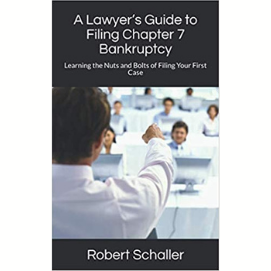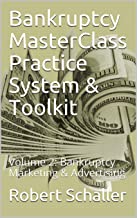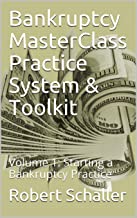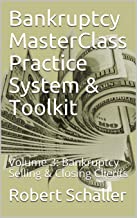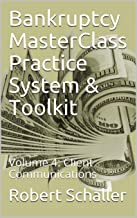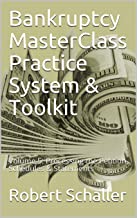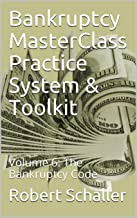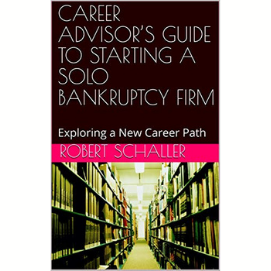A Lawyer’s Guide to Filing Chapter 7 Bankruptcy: Learning the Nuts and Bolts of Filing Your First Case
$249.00This book offers attorneys a 340-page reference book on filing Chapter 7 bankruptcy cases. Included is a line-by-line analysis of the official bankruptcy forms: petition, Schedules A-J, Statement of Compensation, Statement of Intent, Statement of Financial Affairs, Statement of Your Current Monthly Income, and Statement of Means Test Calculation. This is a must-have resource book for any attorney starting a bankruptcy practice. Citing specific authorities, this book offers a deep dive into the U.S. Bankruptcy Code, Bankruptcy Rules, and case law.
All 6 Volumes of Bankruptcy Masterclass
$499.00Add all six Bankruptcy Masterclass volumes to your bankruptcy library.
A $1,500 value for only $499. A $1,001 savings!
- Volume 1: Starting a Bankruptcy Practice
- Volume 2: Bankruptcy Marketing & Advertising
- Volume 3: Bankruptcy Selling & Closing Clients
- Volume 4: Client Communications
- Volume 5: Processing the Petition, Schedules & Statements
- Volume 6: The Bankruptcy Code
Bankruptcy Masterclass – Volume 1: Starting a Bankruptcy Practice
$250.00Invest in your future! Use this book to start building your own bankruptcy law firm. You worked hard in college and again in law school. Now it is time to reap the rewards of your intensive legal training. Earn the profits you deserve! Develop pride in yourself and earn respect from your peers. If you possess a heartfelt desire to build a respected legal career, along with the vision and drive to succeed, then keep reading and embrace the steps set forth in this book.
Separate chapters discuss capital requirements, banking mandates, office leasing, legal structures, tax implications, technology hardware, software, websites, bar associations, marketing, malpractice, insurance, and social media – Facebook, LinkedIn, YouTube, and Google Ads.
Bankruptcy Masterclass – Volume 2: Bankruptcy Marketing & Advertising
$250.00Every lawyer who wants to generate bankruptcy clients, build a book of business, and build a successful bankruptcy practice should read this book. Now, at last, the secrets to legal marketing and legal advertising are revealed in one book. Learn how to generate clients through referrals, direct mail, brochures, content marketing, LinkedIn, YouTube, Google Ads, and Facebook.
A rainmaker understands this simple truth: Marketing = Clients = Profits = Success = Freedom
Without clients, a lawyer is relegated to associate status working for a rainmaker. This book teaches an associate to become a rainmaker so he/she can become the boss.
Demographics and market research are examined because they play a big role in legal marketing. A clear understanding of the target group is essential to effective marketing and eliminates unproductive marketing efforts and squandering of limited marketing resources.
Referrals are a key concept that is discussed from multiple dimensions, including referrals from family and friends, referrals from existing clients. Referral marketing with fellow professionals is also analyzed. A lawyer is urged to target those professionals who enjoy a natural symbiotic relationship with the attorney. Full-text, sample referral letters are provided so that they can be sent to other lawyers, bankers, realtors, and more.
Network marketing is also examined. Networking promotes an attorney and builds solid business relationships with referrers. The resulting referrals solidify prospects’ feeling of trust in the attorney personally and confidence in the attorney’s abilities. Sample networking questions and practice dialogue are provided.
Direct mail is examined it allows a lawyer to segment the market and target those prospects most likely to need legal services. One of the great advantages of direct mail is that a lawyer can reach specific audience segments with personalized messages. The full text of successful direct mail pieces is provided. Brochure marketing is studied in a separate chapter with a focus on the “10 Benefits of Brochure Marketing.”
Bankruptcy Masterclass – Volume 3: Bankruptcy Selling & Closing Clients
$250.00This book discusses the six-step sales process used to close prospective clients so they are delighted to engage the law firm and pay the attorney’s legal fees. First, the rainmaker conducts a Need Analysis during the sales process to determine a prospect’s true need and the real reason the prospect came to meet with the rainmaker. Second, the lawyer asks questions to help the prospect become aware of the prospect’s own true need (i.e., Need Assessment) and not simply the symptom. Third, the attorney offers the Need Solution by connecting the benefits of filing bankruptcy with the prospect’s true need. Fourth, the lawyer identifies all objections and provides additional information to overcome the objections. Fifth, the attorney poses trial close questions when the prospect displays buying signals to gauge the prospect’s level of interest. Sixth, the lawyer offers the Need Satisfaction by asking for the engagement.
In sum, studying this book should help bankruptcy attorneys feel more competent closing deals during the initial consultation phase. Attorneys who embrace this book will be able to engage more clients.
Bankruptcy Masterclass – Volume 4: Client Communications
$250.00Every attorney should read this book cover to cover before seeking his/her first client. Chapter 2 begins with a focus on the ethical requirements surrounding communications with prospective clients. For example, bankruptcy attorneys must be aware of the ethical rules regarding advertising and compensation imposed by their state bar. Plus, attorneys need to comply with the advertising and compensation limitations imposed by the U.S. Bankruptcy Code. These limitations are in addition to, and not an alternative to, the advertising and compensation limitations provided in the state rules of professional conduct. Congress imposed restrictions on any advertisement directed to the general public that indicates that the bankruptcy lawyer provides assistance with respect to credit defaults, mortgage foreclosures, eviction proceedings, excessive debt, debt collection pressure, or inability to pay any consumer debt.
Chapter 3 treats bankruptcy attorneys to a discussion on the importance of client communications to increase profitability and facilitate future client referrals. A bankruptcy attorney has an opportunity to imprint on each client’s psyche the notion that the attorney is a trusted advisor, competent lawyer, caring individual that the client can turn to for advice now and in the future when other legal or financial needs arise. What an opportunity to create a client for life! Chapter 3 presents 15 steps to great client care to enhance profitability through referrals.
Chapter 4 focuses on fact gathering during the initial client consultation. A standardized pre-printed intake form is an essential part of fact gathering. Fact gathering is one of the bankruptcy attorney’s chief goals when meeting with a prospective client for the first time. The intake form allows the attorney to better understand the prospect’s current financial situation and is a starting point for inquiries into the prospective client’s financial problems, goals, and possible solutions. A sample intake form is provided in Chapter 4.
Chapter 5 offers a detailed timeline of a typical Chapter 7 case. Bankruptcy attorneys must be prepared to explain the bankruptcy process to prospective clients. The difference between landing a prospective client and losing a prospective client may be the bankruptcy attorney’s ability to communicate the timeline for Chapter 7 cases. Prospective clients are anxious when they meet a bankruptcy attorney for the first time. The attorney must exude confidence and knowledge. Be ready for the questions about when certain bankruptcy events would occur. A solid familiarity with the bankruptcy timeline is essential. A day-by-day timeline is presented.
Chapter 6 discusses “non-engagement” letter agreements. Not every prospect will engage the law firm. To avoid malpractice claims, bankruptcy attorneys should utilize non-engagement letters that clearly communicate their decision NOT to accept an engagement. Three separate sample non-engagement letters are provided.
Chapter 7 highlights the need to tender bankruptcy disclosures to the prospective client by the bankruptcy attorney prior to a prospective client engaging the attorney. An attorney’s ethical responsibility is to provide a prospective client with sufficient information so that the prospective client can make an informed decision whether to engage the bankruptcy attorney, for what services, and at what cost. Best practices suggest that an attorney document the dissemination of key information. In addition to any ethical requirements, Congress also compelled bankruptcy attorneys to tender these certain disclosures when passing § 342(b) and § 527 of the Bankruptcy Code. Samples of each disclosure is provided.
Chapter 8 addresses written engagement letters, which are a must in every bankruptcy case. A written statement articulating the terms of the engagement reduces the possibility of misunderstanding and offers documentary protection if a disgruntled client claims the lawyer acted unethically. No oral representations. Lawyers are just inviting trouble when the inevitable disgruntled client complains that the scope of the relationship was broader than what the lawyer remembered it to be, or that the disgruntled client complains that the amount of compensation was lower than what the lawyer remembered it to be. Besides, Congress has imposed requirements upon bankruptcy lawyers relating to the engagement letter. First, a bankruptcy lawyer must execute a written contract with the client no “later than 5 business days after the first date on which” the bankruptcy lawyer provides services. A sample Chapter 7 engagement letter is featured.
Chapters 9 and 10 focus on the two-step fact-gathering process necessary to complete the petition, schedules, and statements required to be filed with the Clerk of the U.S. Bankruptcy Court. Fact gathering typically requires multiple communications with the client. As discussed in Chapter 9, each bankruptcy attorney should prepare a checklist of requested documents for clients to produce. The checklist should stress the importance of tendering all the documents on the list that are in the client’s possession and control. The checklist should identify a date by which the documents should be produced to the bankruptcy attorney. Chapter 10 focuses on the client questionnaire, which must be distinguished from the initial intake form completed at the time of the initial consultation. The initial intake form should be considered a brief summary of the prospective client’s financial position. The Chapter 10 client questionnaire is over 50 pages long and provides the details necessary to complete the petition, schedules, and statements. A sample client questionnaire is provided.
Chapters 11, 12, and 13 present sample communication letters relating to the client’s duties and responsibilities AFTER the bankruptcy case was filed. Chapter 11 communications involve tendering the petition, schedules, and statements to the client and urging the client to review the documents for accuracy. Chapter 12 focuses on the § 341 meeting of creditors. Chapter 13 addresses post-petition responsibilities relating to mortgage payments, lease payments, anticipated outcomes, reaffirmation agreements, redemption rights, the automatic stay, adequate assurance deposits to utility companies, and the instructional course concerning personal financial management.
Finally, Chapter 14 offers sample evaluation forms to be sent to each client to help improve the bankruptcy attorney’s practice and increase profitability. Separate evaluation forms relate to the initial consultation, the § 341 meeting of creditors, and the conclusion of the case.
Bankruptcy Masterclass – Volume 5: Processing the Petition, Schedules & Statements
$250.00Every attorney should read this book cover to cover before filing his/her first Chapter 7 bankruptcy case. This book explains the nuts and bolts of filing Chapter 7 – giving attorneys the confidence to provide competent representation to clients by exceeding the minimum competency level of the profession and exercising the skill, knowledge and ordinary care exercised by other attorneys.
This book offers a line-by-line analysis of the official bankruptcy forms prescribed by the Judicial Conference of the United States, including the Petition, Schedules A/B thru J, Statement of Compensation, Statement of Intent, Statement of Financial Affairs, Statement of Current Monthly Income, and Statement of the Means Test Calculation.
In sum, studying this book should make any attorney feel competent to file his/her first Chapter 7 bankruptcy case. Attorneys who embrace this book will be able to better understand the Chapter 7 legal requirements, anticipate bankruptcy issues, and carefully prepare the required petition, schedules, and statements.
Bankruptcy Masterclass – Volume 6: The Bankruptcy Code
$250.00Every attorney should read this book cover to cover before filing his/her first Chapter 7 bankruptcy case. This book explains the nuts and bolts of filing Chapter 7 – giving attorneys the confidence to provide competent representation to clients by exceeding the minimum competency level of the profession and exercising the skill, knowledge and ordinary care exercised by other attorneys.
The goal of this book is to provide attorneys with a structural framework of the bankruptcy process, including a working knowledge of the relevant statutory and judicial authorities. The six types of bankruptcy cases are discussed before examining Chapter 7 eligibility requirements. Next, a day-by-day timeline is presented for a standard Chapter 7 case. Then, the roles of the U.S. trustee and Chapter 7 standing trustee are explored. Plus, the 11 U.S.C. § 341 meeting of creditors is explained followed by a sample Q&A of a typical § 341 examination. Of course, the 11 U.S.C. § 362 automatic stay protections and 11 U.S.C. § 727 bankruptcy discharge are discussed. Typical debtor motions are discussed with text of sample motions provided.
Career Advisor’s Guide to Starting a Solo Bankruptcy Firm: Exploring a New Career Path
$249.00Some lawyers have the courage to open a solo-practice law firm. Other lawyers start a law firm with one or two other lawyers they know and trust. There is strength in numbers. It is appealing to young lawyers in particular to have a law school classmate or fellow associate nearby for support. Others establish an “affiliation” with an existing firm. Sometimes a lawyer needs another lawyer to brainstorm and bounce ideas around. This book provides lawyers with a step-by-step manual for filing their first Chapter 7 case. Included is a line-by-line analysis of the official bankruptcy forms: petition, Schedules A-J, Statement of Compensation, Statement of Intent, Statement of Financial Affairs, Statement of Your Current Monthly Income, and Statement of Means Test Calculation.
Specific, real-world examples are offered for property in Schedule A/B, exemptions in Schedule C, secured creditors in Schedule D, unsecured creditors in Schedule E/F, executory contracts and unexpired leases in Schedule G, co-debtors in Schedule H, income in Schedule I, and expenses in Schedule J. Separate chapters discuss the six types of bankruptcy cases, the timeline for Chapter 7 cases, alternatives to Chapter 7, a client’s eligibility for Chapter 7 relief, and the role of both the Chapter 7 panel trustee and the U.S. Trustee. Plus, separate chapters analyze the automatic stay injunction and the Chapter 7 discharge injunction.

